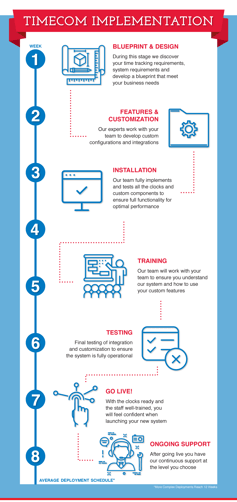TimeCom is an advanced cloud-based attendance tracking solution that works seamlessly with Workday time tracking systems. Throughout our extensive experience with Workday customers, we have identified the common questions companies have about integrating their workforce management systems with our TimeCom solution. Here are the six we hear most often and earliest in our conversations.
HOW LONG DOES IT TAKE TO CONFIGURE A WORKDAY TIME CLOCK?
We ship the time clocks to you fully configured to your specifications. The ATS sales and implementation teams work with you to define the time clock configuration you want to deploy and once the requirements have been completed, our manufacturing and production teams will build the clock to your specific request. The ATS team then tests each time clock you’ve ordered to ensure it is operational before shipping it to your location(s).
HOW DOES EACH TIME CLOCK GET INSTALLED?
ATS time clocks are easy to install because they are truly plug-and-play. Here’s how it works:
We deliver them directly to every location where you need them. Your team attaches the time clock to the wall at the entry spots where you want them. Once they connect the time clock to a power source and your internet connection, the time clocks boot themselves up. How? As soon as a time clock connects to the internet, it sends a message to the Timecom middleware, and the middleware autocompletes the installation process. Then your time clocks are ready to use.
wHAT resources do we need available to manage the time clock boot up after installation?
Very few and they don’t need to be physically on site at each time clock location. As noted above, the time clocks will auto–boot once they’re connected to a power source and your internet connection.
Your IT team can monitor the time clocks getting online and going operational from ClockWatch, part of the TimeCom management portal.
ClockWatch™ is a web-based tool that provides your IT team with real-time monitoring of time clock operability and data flow expected between your Workday time clock integration and your Workday system. The main ClockWatch™ dashboard gives the IT team a clear, graphic representation of the connectivity status of every ATS time clock you’ve deployed. So as the team installs the time clocks, the IT team will see the time clocks come online via the ClockWatch™ dashboard.
how quickly can our employees start using the time clocks?
.png?width=336&height=336&name=Screen%20Shot%202023-06-29%20at%2010.29.27%20AM%20(2).png)
Almost immediately. Once the time clocks communicate with the middleware, the integration between the ATS time clocks and your Workday solution goes live. The middleware pulls the employee data sets, as defined by your company during the specification phase of the implementation plan.
Once the employee data sets are installed on the time clock, employees can start clocking in and out.
If your company has opted to use a biometric reader, employees will have to enroll in the biometric attendance tracking system before they can start clocking in or out. They enroll right at the time clock and the TimeCom time clock software will step them through the process. Once enrolled, they can immediately clock in.
what happens if our company needs a new time clock?
Contact your sales representative or customer support.
If you need new time clocks to serve your growing business, contact your sales representative. Your sales representative can walk you through the process of ordering additional time clocks. One of the benefits of TimeCom is that since we already have your time requirements, we can build and ship your new time clock within two weeks.
what happens if our company needs to replace a time clock?
%20Never%20pay%20twice%20for%20shipping!%20-%20%20Follwup%20graphic%20email-4.png?width=325&height=325&name=EATC22710%20-%20Intro%20to%20timecom%20(10)%20Never%20pay%20twice%20for%20shipping!%20-%20%20Follwup%20graphic%20email-4.png) Enrolling in our Express Exchange Service (ESS), is the fastest and most cost-effective way to get a replacement for a damaged or failed time clock. If you enrolled in our ESS program, we can have your new time clock, configured to your specifications on file, in your hands the next day after your request comes in.
Enrolling in our Express Exchange Service (ESS), is the fastest and most cost-effective way to get a replacement for a damaged or failed time clock. If you enrolled in our ESS program, we can have your new time clock, configured to your specifications on file, in your hands the next day after your request comes in.
Contact your account manager to submit an ESS replacement request for a time clock.
how long does a full deployment process take?
The typical deployment for a Workday time tracking integration project takes eight weeks. Depending on the size of your deployment and whether it requires additional development, the process may take longer. We define our deployment process by four phases:
- Integration (weeks 1-2): This is where our teams work together to specify the
 configuration and data integration requirements for your deployment. Because TimeCom is custom-built to integrate with Workday Time Tracking, much of the heavy integration lifting is already done at this stage.
configuration and data integration requirements for your deployment. Because TimeCom is custom-built to integrate with Workday Time Tracking, much of the heavy integration lifting is already done at this stage.
- Pilot (weeks 3-5): Our team tests and debugs your time clock configuration and integration in our test environment to prepare for production.
- Production (weeks 6-8): All components of your TimeCom system roll out, including time clocks, integration, and the ClockWatch™ management portal. During the go-live phase, the ATS support team is with you monitoring the roll out and providing training.
- Ongoing support (after 8 week deployment): ATS teams provide ongoing support and guidance so your company gets maximum value from the integrated systems.
After the official deployment process has ended, the ATS customer support team remains available for ongoing support.

have more questions? we have more answers
You can read more about TimeCom and its ClockWatch™ clock management portal for more information. Check out our blog for deeper looks at how TimeCom integrates with Workday Time Tracking here and read some case studies of real world implementations here.
Of course, if you want to talk with an ATS consultant to learn more about what TimeCom can bring to your company - contact us to set up a demo.




.png?width=336&height=336&name=Screen%20Shot%202023-06-29%20at%2010.29.27%20AM%20(2).png)
%20Never%20pay%20twice%20for%20shipping!%20-%20%20Follwup%20graphic%20email-4.png?width=325&height=325&name=EATC22710%20-%20Intro%20to%20timecom%20(10)%20Never%20pay%20twice%20for%20shipping!%20-%20%20Follwup%20graphic%20email-4.png)


